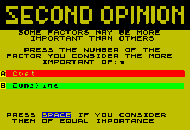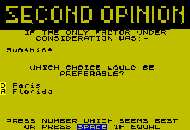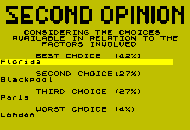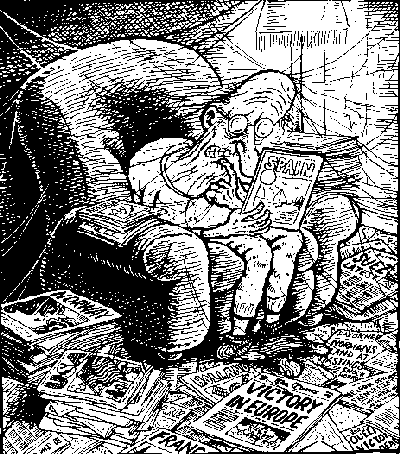Issue 19, October 1985 - Second Opinion
| Home | Contents | KwikPik |
| SECOND OPINION So, you used to be indecisive, but now you're not so sure, eh? Fortunately, Chris Somerville has come to your rescue with a program that'll help you reach some more definite conclusions. |
Don't delay the decision - type the listing
in now! It's never too late to call in a
second opinion! As this program is available on "ZIPi'T'ape", I have not reproduced the Basic listing here. DECISION TIMEPretty obviously, the computer can't really make your mind up for you. What it can do is help you to organise your thoughts by forcing you to follow a certain logical procedure. And it does this by breaking down a large complex analysis into a series of simple decisions. As you can see here, you're only ever presented with the Factors involved in a decision, in pairs. You're then asked to indicate their relative importance. Since each Factor is sequentially compared with every other Factor a numerical strength can be allocated to each. This is where the computer scores over the usual muddled, fuddled human activity that masquerades as thinking. A good example of this is those classic compos you'll have seen in YS, for instance. You know, the ones where you have to list in order of importance all the attributes of a particular product. You usually end up like a mental contortionist as you compare each attribute with the whole list. Now say the attributes were all entered as Factors in this program, well then you'd only have to compare each one with one other and make a decision as to its relative importance. The end result would be a list automatically in logical order of importance and most important of all it would still be firmly based on human judgement.  Once you've covered the Factors, it's just a question of selecting the better Choice of two when only one Factor is involved. Each separate preference is recorded, scored and modified by the strength, which you've previously established, of the Factor involved. Then finally, the Choices are sorted using the Choice score number array C(). The end result is displayed in the form of the three best Choices, and the worst, with the scores given as a percentage.  | |
|---|---|---|
|
Has anyone seen an executive toy on the
market called a Decision Maker? It's
battery operated and delivers, at the press
of the button, helpful advice in the form
of a randomly generated Yes, No or
Maybe. Without any help from it at all, I
came to my own decision not to buy one. Mind you, I still reckon that a computer can be really useful in helping in the process of decision-making. That's why I've written a program that'll help you arrive at a logical decision in any situation where multiple choices are involved and where there are many factors to be taken into consideration. What's the next piece of software that you're going to buy, where are you going on holiday and should it be the Porsche or the Roller this year? It's just so hard to choose - until now! HOORAY FOR ARRAYSThe first task is to set up two string arrays to hold the possible Choices and the Factors that'll affect them. And as we can't appreciate just how many they'll be in any given problem, it's fortunate that on the Speccy we can DIMension the arrays from within the program, changing |
their size as needs be. That means that
although line 160 sets up two temporary
arrays of ten elements, they can grow as
large as you require. It works like this -
the various Choices are lodged in
duplicate, A$(1) = B$(1) and so on, and
a count is kept as you enter each Choice.
If the count reaches the limit of the array,
then one array can be re-DIMensioned to
accommodate additional information,
while all the info you've already entered
is safely held in the duplicate array. Eventually, the Choices finish up in a correctly DIMensioned C$() and then A$() and B$() are re-used to collect the Factors which end up in F$(). And don't worry about muddling up your Factors and your Choices as you'll be prompted throughout the program. Of course, there's one decision this program can't make for you - whether or not to type it in. You're just going to have to make your own mind up on that one. But I reckon if you're hesitating, then you're just the type of person who needs this very program. Then again, you could always save yourself the hassle and buy this month's Digi'T'ape. Oh, decisions, decisions! | |

| ||
| Home | Contents | KwikPik |